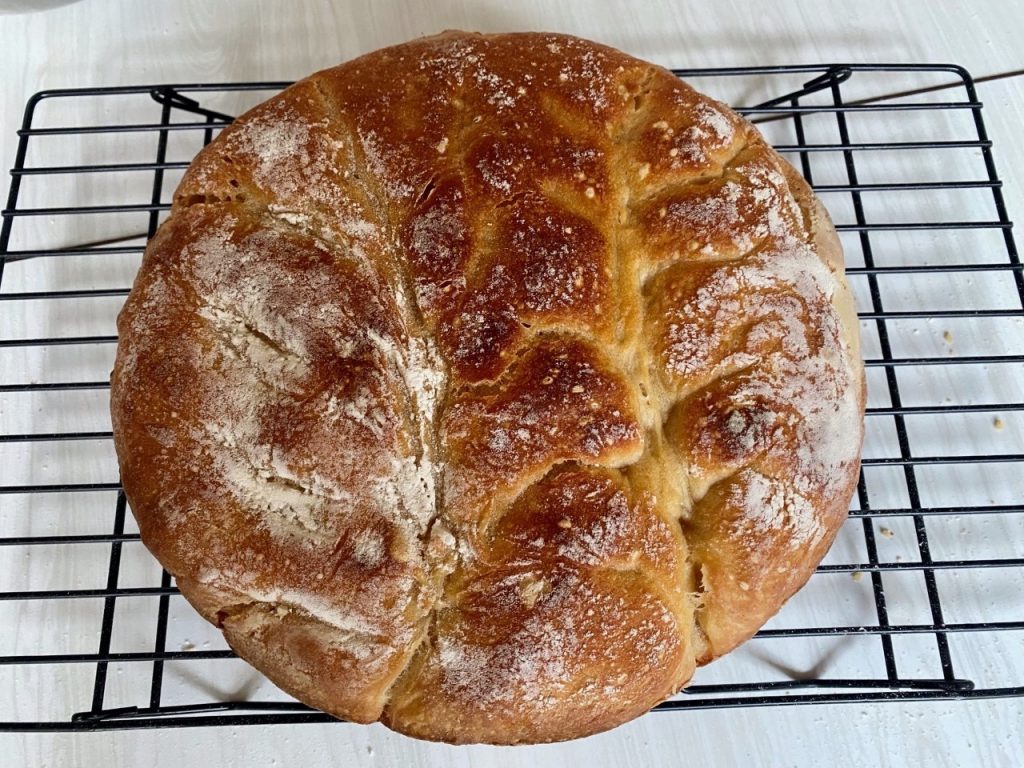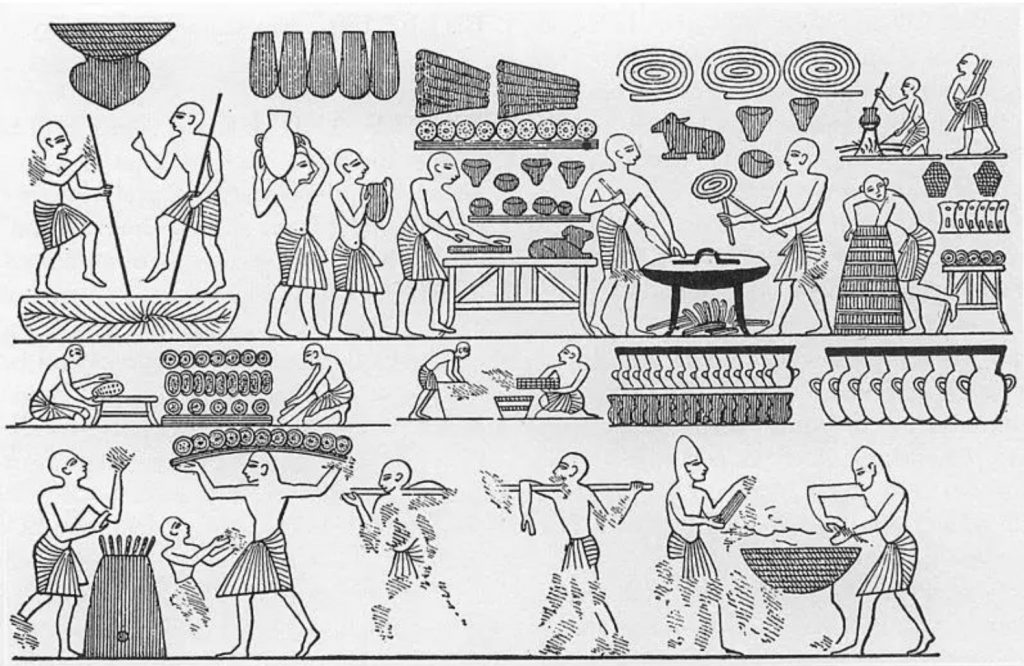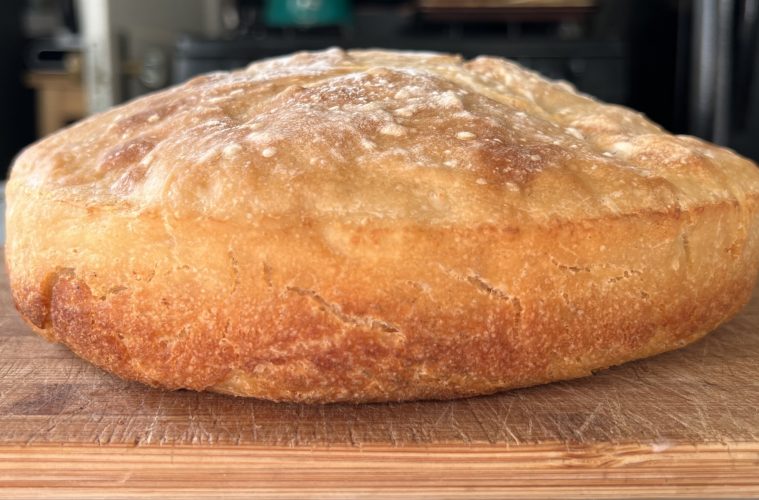My mother knew I was curious about baking sourdough. So, she set about researching the subject and through her tech savvy eventually landed on the website for King Arthur Baking Company. Soon after, a package for my birthday arrived in the mail; a Glass Sourdough Crock Set and Fresh Sourdough Starter – instructions on the jar read, “Feed Me!”.
Curiosity ensued, followed by a rabbit hole of information on sourdough, leading directly into an abyss of intimidation; until, an attitude of Oh, the hell with it; let’s give it a try, washed over me. So, I moved forward. The instructions in the booklet explained that the Starter needed to be “fed” right away. What is this, a kitten, or a loaf of bread?
And, that’s how my sourdough bread making journey began.
What is Sourdough Starter?
A small amount of live fermented culture, made of flour and water, set out at room temp and fed every 8-12 hours with water and flour.
Feed, You Say?
Yes. What you feed the mixture are natural yeasts, which are in the air, on just about every surface, and most importantly, found in flour. When you feed yeasts with the right ratio of flour and water they multiply and grow (which, is why you must remove a portion of the starter dough prior to each feeding).
Over time this dough naturally ferments cultivating healthy probiotics, as well as that lovely tangy flavor that makes sourdough so special. Most of those probiotics, unfortunately, do not survive the heat when baked. But, prebiotics are created in their place and are considered by many health experts nutritionally beneficial, especially when it comes to good gut health.

Baked this loaf a bit longer and made it a bit more Sourdoughy
The Art of Bread Making
For a novice home baker like me, the art of bread making is fascinating; I feel a part of the culture, history and science throughout the process. And, Sourdough has its own culture as diverse as any community. A search for internet groups or blogs will reveal just how much love surrounds this one type of bread, alone. As with all good things, however, comes much debate.
There are those, for example, who follow very regimented rules and break down the process on a molecular level. Then, there are old school methods of eyeballing the measurements, adding a little of this and a little of that. For beginners, like me, there is plenty of advice and suggestion on the internet – good, bad and overwhelming – so be aware when you decide to take a look. On rare occasion, discussions can get a bit tangy …
My advice, when making bread, is to keep it simple. Don’t fret over imperfection. People have been baking some form of sourdough for centuries and it is not like they all had precise measuring tools. They figured out what worked for them, and so can you.
The thing with sourdough is that you have to pre plan. First rise is three hours, second rise is two hours (but, of course, it varies from recipe to recipe). So, if I am in the middle of a busy day, there will be no sourdough.
The key to any good sourdough is to have a very active Starter. Therefore, bring the Starter to room temperature. Other than that, there are many recipes online to choose from. Or, maybe, you have a family recipe you have been considering? If you’re like me, you will likely tweak those over time to develop your own perfect loaf.
In my home, I work on a 1940s formica kitchen table. It holds all of my ingredients and tools, giving me plenty of space to create. Depending on my mood, I listen to my playlists. I very much enjoy this time. Once the sourdough is out of the oven I let it set on the table. Often, I am baking two loaves at night so that in the morning they catch the morning sun coming through our kitchen windows – quite a rewarding sight!
But, what I enjoy most about baking sourdough is my ability to feed my family real food.

Bake like an Egyptian: (Ramses III, 20th Dynasty, 1167 B.C.)
A Brief History (to accompany your morning tea)
One might say The King Arthur Baking Company is as American as Apple Pie, and they wouldn’t be wrong. For over two centuries King Arthur Baking Company has been a fixture in American baking.
According to The King Arthur Baking Company, it all began in 1790 with Henry Wood and Company, America’s first flour company. At that time, Henry Wood imported flour from England and established his flour company in Boston. In the 1820’s wheat farming in America flourished, enabling Henry Wood & Company to end their import of English flour to produce and sell American milled flour.
In 1896, The Sands, Taylor & Wood Company introduced its new and improved flour, along with a new name, at the Boston Food Fair; naming it King Arthur, for its Arthurian attributes: Purity, loyalty, honesty, superior strength, and a dedication to a higher purpose.
Sourdough starter has been around for centuries and can even be traced back to ancient Egypt . Typically, Roman bread was sourdough, with recipes by Pliny the Elder still gaining appeal, like his Chuckling Vetch Sourdough bread starter.
During the American frontier, many trappers and minors carried crocks or pots of sourdough starter with them. Sourdough starter had been carried around for bread making by many 49ers. They’d drive their wagons from camp to camp while toting precious starter and flour. Due to the popularity with the gold rush minors, bakeries in San Francisco mixed the sourdough starter with a French style loaf of bread and thus we have the birth of an American legacy, San Francisco Sourdough Bread , which began in 1849.
Now Back to My Starter
The Fresh Sourdough Starter from King Arthur Baking Company is a decedent of their starter from the 1700’s! I find it truly amazing to hold this piece of history in my hands and possibly make it a part of my family history. If one were so dedicated, they could pass down a descendent of this starter from generation to generation – the gift that keeps on giving (but, in a good way).

